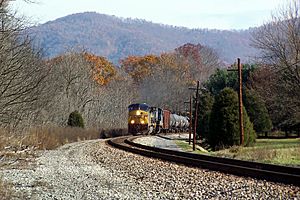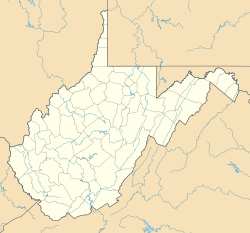Pence Springs, West Virginia facts for kids
Quick facts for kids
Pence Springs, West Virginia
|
|
|---|---|

A CSX freight train passes through Pence Springs in 2007.
|
|
| Country | United States |
| State | West Virginia |
| County | Summers |
| Elevation | 1,539 ft (469 m) |
| Time zone | UTC-5 (Eastern (EST)) |
| • Summer (DST) | UTC-4 (EDT) |
| Area code(s) | 304 & 681 |
| GNIS feature ID | 1555323 |
Pence Springs is a small, quiet community in Summers County, West Virginia. It is located along the Greenbrier River, east of the city of Hinton. The community sits at an elevation of 1,539 feet (469 meters). It used to have its own post office, which closed in 2011.
Pence Springs was once a popular place for visitors. Today, it is home to a large flea market. This market is held in the building that was once used to bottle water from the famous spring. The water from this spring even won awards at the St. Louis Expo in 1904. In 1918, Andrew Pence built a large hotel above the spring. This hotel attracted many tourists. Later, it was used as a state women's prison for several decades. The old resort building is now home to the Greenbrier Academy for Girls. The Pence Springs Hotel Historic District is a special area listed on the National Register of Historic Places since 1985.
In the past, other hotels and boarding homes were built in Pence Springs, but none of them are still standing. Across the Greenbrier River, there used to be busy stockyards and a train station. Train service to the area stopped in 1952. There is also a small grass landing strip nearby called the Hinton-Alderson Airport.
Contents
Pence Springs: A Look at Early History
Like many areas around it, Pence Springs was first home to ancient mound builders. Later, Native American tribes lived here. After Captain John Smith founded Jamestown, Europeans began to move into what is now Summers County.
The first known white settler in the Pence Springs area was William Kincaid. He settled on land that later became known as the Jesse Beard Plantation. On this land was the famous Pence Springs, which was then called Buffalo Springs. It was known as a "buffalo lick" because animals like buffalo, elk, and deer would come there to lick the mineral-rich ground. For over a hundred years, it was a prime hunting spot. William Kincaid moved further west around 1800.
Who Were the First Settlers?
William Kincaid was the earliest known settler in Pence Springs. We don't have records of others who might have settled there at the same time. However, we know about a land grant to Colonel James Graham in 1758. Colonel Graham settled in Lowell, West Virginia.
- One of his daughters, Jane, married David Jarrett. They settled at Buffalo Spring on land later called the Mazi farm.
- A grandson of Colonel Graham settled on land that became known as the Haynes place. Part of this land was later called the Nowlan and then the Tolley Place.
Jesse Beard, from Pocahontas County, owned a large area of land in Pence Springs. This was called the Beard Plantation and included the famous spring. Jesse Beard died around the end of the Civil War. He is buried in the Beard/Nash Cemetery. His land was divided among his five children. His daughter Sarah, who married Charles R. Hines, built a house on her inherited property. This house later became known as the Hines Boarding House.
James Madison Haynes, from Monroe County, moved to Greenbrier County in 1840. He bought the Samuel Graham property, located five miles (8 km) below Alderson on the Greenbrier River. This part of the property later became known as the Haynes Ferry. James Haynes died in 1858, leaving six children. His son, William Haynes, became a state senator in 1871.
John Nowlan and Florance Graham Nowlan settled on Hungrets Creek in 1835. They were the grandparents of M.C. Nowlan, known as "Mac," from Pence Springs. Their son, Joseph Nowlan, married Mary Keeny in 1865. They bought part of James M. Haynes's land and built a large brick house there. The Nowlan family was very important in the community's growth. John was a candidate for Summers County commissioner in 1890 and for sheriff in 1892. His son, John Jr. Nowlan, was the first postmaster of Pence Springs, when it was called Stock Yards.
Pence Springs got its current name from Andrew P. Pence. He was from Monroe County and was the grandson of Elizabeth Graham. Pence bought the property with the spring, about 280 acres, from Jesse Beard's family. Thanks to Andrew Pence, the old spring became very famous in West Virginia. It gained national recognition when its water won a silver medal at the World's Fair in St. Louis in 1904. Mr. Pence built a large hotel, and because it couldn't hold all the guests, other smaller hotels were built, like the Lahey Boarding House.
The original Pence Springs Hotel burned down in the early 1900s. Andrew Pence and Mr. T. Davis then built the current Pence Springs Hotel. This building was used as the State Prison for Women from the 1940s to the 1980s.
Learning in Pence Springs: Early Education
The first school in the area was called The Mays School. It was located near Valley Heights, above the spring. There was also the Kellan School, near Lowell on the south side of the river. The Buffalo School was established next. Its original building was renovated in 2008 and stands below the Beard Nash Cemetery. Later, the Bush school was built.
In the early 1900s, these three schools combined to form the Pence Springs School. It was located on Route 3 in Pence Springs. This school building burned down in 1941. After the fire, classes were held in the Lahey Boarding House. A new brick school building was completed in 1942 on the same site, and it is still standing today.
The Pence Springs Hotel Becomes a Prison
After John William Johnson passed away in 1930, the Pence Springs Hotel property was part of his estate for 14 years. Those in charge tried to sell it but couldn't find a buyer. Finally, in 1944, the Pence Springs Resort was sold to the Hugh and Hall Adams Corporation for $27,500.
At first, there was no public announcement about what the new owners planned to do with the resort. News reports suggested they might spend a lot of money to fix it up and reopen it as a health resort. However, these plans never happened.
Meanwhile, the State Board of Control was looking into the State Penitentiary in Moundsville, West Virginia. They found that the facilities for women inmates were not good enough. Women were housed in the same type of cell blocks as male prisoners. Joseph Z. Terrell, who was the Warden at Moundsville, had been trying for a long time to get a separate facility for women. Now, he was in a position to make it happen.
Terrell explained the poor conditions at Moundsville to the West Virginia Legislature. He said the best solution was to create a State Prison for Women. Based on his recommendation, the 1945 West Virginia Legislature set aside $203,000 to build this new prison. Terrell said he had been working for a women's prison for thirty years and believed it was a very important step for the state.
The State Board of Control looked at many places for the new prison. Terrell said they considered about a dozen locations, including an old college building. One day, he drove past Pence Springs and thought the hotel might be a good option. His colleagues on the board liked the idea right away.
The state then got an option to buy the hotel property for $45,000. In May 1946, the legislature recommended that the board buy it. The hotel was now set to become a prison.
The following month, money was released to buy and remodel the hotel. Terrell announced that as soon as the building was ready, 70 to 90 women from the Moundsville prison would be moved to Pence Springs. In July 1946, the hotel property and its furniture were officially purchased. The Adams Corporation kept the mineral spring and bottling plant, along with the trademarks for the hotel and its sulfur water.
Alexander Mahood, an architect from Bluefield, was hired to design the changes needed to turn the resort into a state prison. Terrell estimated that about $35,000 would be needed for a new water and sewage system, and up to $115,000 for other changes, including a new heating plant. They hoped to have the property ready by the start of the next year.
Mahood began working on the 81-acre property almost immediately. He was a leading architect in the state. The installation of the new water and sewage system started on July 18, 1946. This work was done by Housby Brothers of Alderson, West Virginia, and supervised by J.E. Settle, an engineer. The first part of the project involved installing a water pump on the Greenbrier River and a sewage disposal system. After that, a storage tank and water treatment plant were built.
Mahood met with the State Board of Control in September 1946 to discuss the plans for converting the hotel into a prison. The plans were drawn up the following week. The new water and sewage system was expected to be finished by the end of that month.



